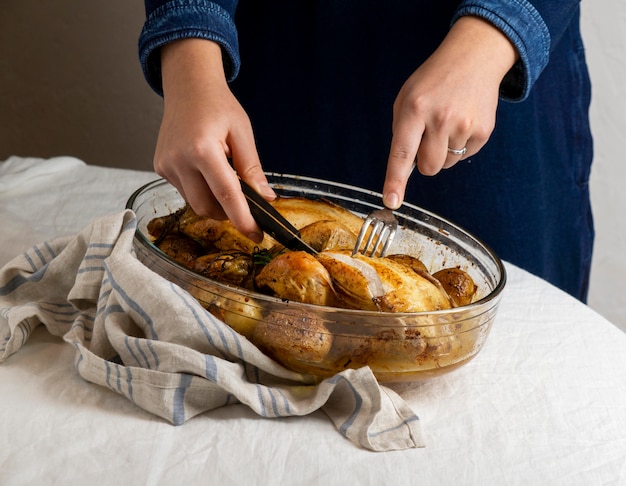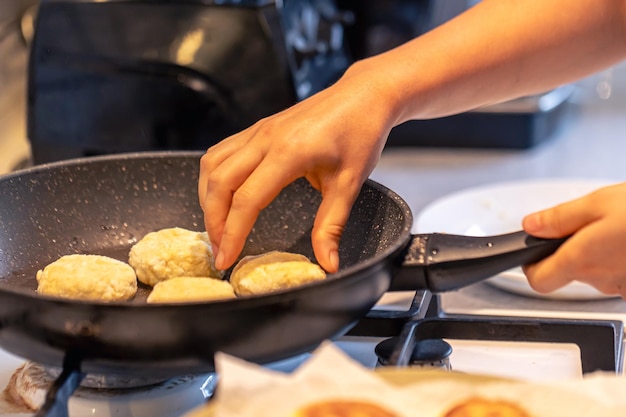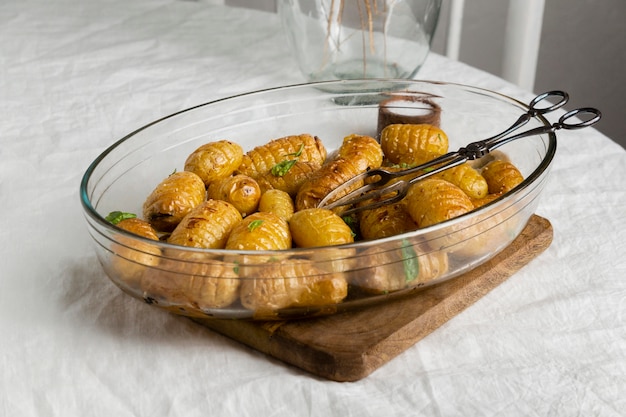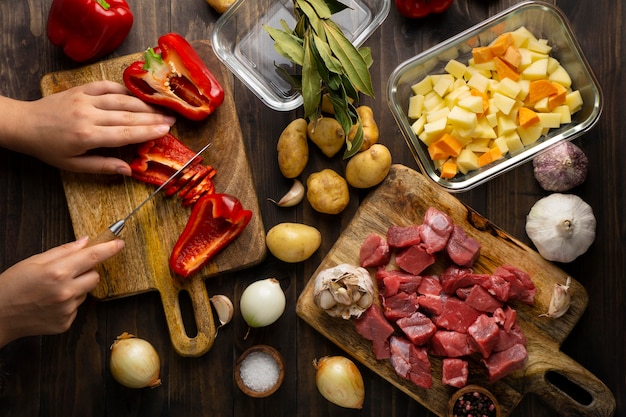Alright, let's talk about baked potatoes. We've all been there, haven't we? Standing by the oven, staring at the clock, wondering if that spud is finally done. It's a classic dilemma, and one that's plagued me for years. You see, there's nothing quite like a perfectly baked potato. That fluffy, steaming centre, the crispy skin, the endless topping possibilities - it's culinary bliss. But getting it right is a bit of a balancing act. Overcook it, and it becomes a mushy mess. Undercook it, and you're left chewing on a brick.
This guide is my attempt to demystify the art of baking the perfect potato. I'm going to share my experiences, my tips, my tricks, and even a few of my favourite recipes. Get ready for a deep dive into the world of baked potatoes, and by the end, you'll be a master spud baker. Let's get started!
(Part 1) Understanding the Basics

The Potato Matters
Let's start with the foundation: the potato itself. Choosing the right spud is the first step towards baked potato greatness. My go-to choice is always a russet potato, or Idaho potato, as they're sometimes called. They have a high starch content, which translates to a fluffy, pillowy texture once baked. They've got a decent size too, making them perfect for holding a good dollop of toppings.
Why are russets the best? Well, their high starch content means they hold a lot of water. As they bake, that water turns into steam, creating that beautiful, fluffy centre. You want a potato that's dense enough to hold its shape, but not so dense that it takes forever to cook.
Now, you might be wondering about other varieties. You can certainly use Yukon Golds, but they'll be a bit more waxy, so don't expect that super fluffy centre. They're fantastic for mashed potatoes or roasted potatoes, but not the best choice for baking. Red potatoes are also an option, but they tend to be a bit denser and can take a little longer to bake. They're more suited to roasting or salads. If you're going for a truly crispy skin, then a yellow potato might be your best bet. These have a thinner skin and are often used for roasting.
Baking Time: It's All About Size
Alright, so you've got your potato, now let's talk time. Baking time is going to vary depending on the size of your spud. A small potato, say about 4 inches in diameter, will bake in around 45 minutes. A larger potato, 6 inches or more, could take anywhere from 60 to 90 minutes.
Remember, the key is to bake until the potato is tender. You can check for doneness by poking the potato with a fork. It should slide in easily, without resistance. If you feel any firmness, it needs more time.
(Part 2) Methods of Baking

The Traditional oven method
This is the classic way to bake a potato, and it's a method that works wonderfully. Simply preheat your oven to 400°F (200°C), scrub your potatoes, and prick them with a fork a few times to prevent them from exploding in the oven. Place the potatoes on a baking sheet lined with parchment paper, and bake until they're tender. You can even wrap the potatoes in foil, which will help them cook more evenly and create a lovely, steamy interior.
Why prick the potato? Think of it like releasing pressure from a pot. The steam created inside the potato needs somewhere to go, otherwise, it could burst.
The Microwave Method
This is a quick and easy option, especially if you're short on time. Simply prick the potato with a fork, place it on a microwave-safe plate, and cook on high for 5-7 minutes per potato. You may need to adjust the cooking time depending on the wattage of your microwave and the size of the potato.
Be careful with the microwave method, as it can sometimes result in an unevenly cooked potato. You might end up with a soft centre and a hard exterior.
The slow cooker method
If you're a fan of slow cooking, this method is for you. Simply place the potatoes in the slow cooker, cover with water, and cook on low for 4-6 hours, or on high for 2-3 hours. This method results in a truly tender and fluffy potato, and it's perfect for a set-it-and-forget-it approach.
This is great if you're preparing a large batch of potatoes for a party or gathering. Just throw them in the slow cooker and let them cook while you focus on other things.
(Part 3) cooking tips and Tricks

The Power of Pre-Heating
One of my favourite tricks is to pre-heat the potato before baking. Simply place the potato in a bowl of hot water for about 15 minutes before baking. This will help the potato cook more evenly and will reduce the overall baking time. It's a simple step, but it really makes a difference.
Think of it as getting the potato up to temperature before it goes into the oven. This helps the interior cook more quickly and evenly, leading to a better overall result.
Foil or No Foil?
That's the question, isn't it? I tend to favour foil, especially for larger potatoes. The foil traps steam, creating a more moist and tender potato. However, if you're aiming for a crispy skin, then baking without foil is the way to go.
If you're aiming for a crispier skin, then baking without foil is the way to go. The exposed potato will dry out slightly, allowing for a crispier exterior.
The Salt Trick
Here's another little tip: salt your potatoes before baking. Adding a sprinkle of salt to the surface will help to draw moisture out of the potato, resulting in a crispier skin.
This is a classic trick that works wonders. The salt draws out moisture from the potato, creating a crispier skin. It also adds a bit of flavour to the potato.
The Baking Sheet Trick
Now, here's a tip I learned the hard way. Don't overcrowd the baking sheet. Leave some space between the potatoes to allow for proper air circulation. This will help them bake evenly and prevent them from steaming instead of baking.
Crowding the baking sheet will lead to uneven cooking and possibly soggy potatoes. Spacing them out allows for better heat distribution and prevents steaming.
(Part 4) Troubleshooting Common Problems
My Potato is Not Baking Evenly
This is a common issue, especially if you're using a large potato. The solution? Rotate the potato halfway through baking. This will ensure that all sides are exposed to the heat and that it cooks evenly. You can also use a baking sheet with a raised rack to allow for better air circulation.
Sometimes, the bottom of the potato cooks faster than the top. Rotating the potato ensures that all sides get equal exposure to the heat.
My Potato is Too Soft and Mushy
This is a sign of overcooking. The best way to prevent this is to check your potato regularly. Use a fork to test for doneness. If it feels soft and mushy, it's likely overcooked. You can try to salvage it by scooping out the soft bits and using them for mashed potatoes or potato soup.
The key is to check the potato for doneness before it gets overcooked. Overcooked potatoes are not as pleasant to eat.
My Potato Has Exploded in the Oven
This is a classic potato baking disaster, but it's easily avoidable. Prick your potato several times with a fork before baking to allow steam to escape. Pricking the potato releases the steam and prevents it from building up inside, which could cause it to explode.
(Part 5) The best baked potato toppings
Classic and Delicious
Butter and Salt: This is the ultimate classic. The creamy butter melts into the fluffy potato, and the salt brings out the flavour. Simple, yet satisfying.
Sour Cream and Chives: A cool and tangy topping that adds a touch of freshness to the warm potato.
Chili and Cheese: A hearty and satisfying topping, perfect for a chilly evening. Use your favourite chili, and top with shredded cheese of your choice.
Bacon and Blue Cheese: A bold and flavourful combination that will tantalize your taste buds. Crumble some crispy bacon over the potato, and top with a dollop of creamy blue cheese.
Creative and Unique
Avocado and Lime: A fresh and healthy topping that adds a burst of flavour. Mash some avocado, sprinkle with lime juice, and top with a pinch of salt.
Roasted Garlic and Herbs: A delicious and aromatic topping. Roast some garlic cloves until they're soft and spreadable, then mix with chopped herbs like rosemary and thyme.
Spicy Chorizo and Cilantro: A fiery and flavorful topping that will add some kick to your potato. Saute some chorizo with onions and peppers, and top with fresh cilantro.
Roasted Peppers and Goat Cheese: A sweet and tangy topping that's both delicious and visually appealing. Roast some red or yellow bell peppers, and top with a dollop of creamy goat cheese.
(Part 6) Baked potato recipes
Classic Baked Potato with Butter and Salt
Ingredients:
1 large russet potato
2 tablespoons butter
Salt and pepper to taste
Instructions:
Preheat your oven to 400°F (200°C).
Scrub the potato, prick it with a fork, and place it on a baking sheet.
Bake for 60-75 minutes, or until tender.
Cut the potato in half, add butter, salt, and pepper, and enjoy!
Cheesy Chili Baked Potato
Ingredients:
1 large russet potato
1/2 cup chili
1/4 cup shredded cheddar cheese
Sour cream and chives, for garnish
Instructions:
Preheat your oven to 400°F (200°C).
Scrub the potato, prick it with a fork, and place it on a baking sheet.
Bake for 60-75 minutes, or until tender.
Cut the potato in half, add chili, and top with cheese.
Garnish with sour cream and chives, and serve.
Mediterranean Baked Potato
Ingredients:
1 large russet potato
1/4 cup crumbled feta cheese
1/4 cup chopped Kalamata olives
1/4 cup chopped red onion
1/4 cup chopped fresh parsley
Lemon juice, to taste
Instructions:
Preheat your oven to 400°F (200°C).
Scrub the potato, prick it with a fork, and place it on a baking sheet.
Bake for 60-75 minutes, or until tender.
Cut the potato in half, and top with feta cheese, olives, red onion, parsley, and lemon juice.
(Part 7) Beyond the Basics: baked potato variations
sweet potato variations
sweet potatoes, with their naturally sweet and vibrant flavour, are perfect for baked potato variations. Here are a few ideas:
Sweet Potato with maple pecan topping: Mix maple syrup, pecans, and butter for a sweet and nutty topping.
Sweet Potato with Cinnamon Sugar: For a simple and classic twist, sprinkle cinnamon sugar over the baked sweet potato.
Sweet Potato with Coconut Cream: For a tropical twist, top with coconut cream, shredded coconut, and a touch of honey.
stuffed baked potatoes
Stuffed baked potatoes take the classic dish to a whole new level. Here are some ideas:
Chicken and Broccoli Stuffed Baked Potato: Fill the potato with cooked chicken, broccoli florets, and a creamy cheese sauce.
Tuna Salad Stuffed Baked Potato: Mix tuna salad with mayonnaise, celery, and onion, and fill the potato.
Taco Stuffed Baked Potato: Add taco meat, cheese, lettuce, tomato, and sour cream for a hearty and flavorful stuffed potato.
Baked potato salads
Baked potatoes can also be used to make delicious salads. Here's a simple recipe:
Baked Potato Salad:
Ingredients:
2 large russet potatoes, baked and diced
1/2 cup mayonnaise
1/4 cup chopped celery
1/4 cup chopped red onion
1 tablespoon Dijon mustard
Salt and pepper to taste
Instructions:
Combine all ingredients in a bowl and mix well.
Chill for at least 30 minutes before serving.
(Part 8) Baked Potato Etiquette: Tips for a Perfect Presentation
Presentation Matters
Let's be honest, a beautifully presented baked potato is even more appealing. Here are a few tips to elevate your baked potato game:
Use a baking sheet with a raised rack: This allows for even cooking and creates a lovely, crispy skin.
Cut the potato neatly: Use a sharp knife to cut the potato in half, or into wedges for a more rustic presentation.
Top with care: Arrange toppings in a visually appealing way. Use a piping bag for a more professional look.
Serve immediately: Serve the baked potato hot and fresh for the best flavour.
(Part 9) FAQs
1. How do I know when my baked potato is done?
The best way to check for doneness is to insert a fork into the potato. It should slide in easily, without resistance. If it feels firm, then it needs more time in the oven.
2. Can I bake potatoes ahead of time?
Yes, you can bake potatoes ahead of time and reheat them later. Simply bake the potatoes according to the instructions, then wrap them in foil and store them in the refrigerator for up to 3 days. To reheat, unwrap the potatoes and bake them in a preheated oven at 350°F (175°C) for 15-20 minutes, or until heated through.
3. What if my potato is too big for my oven?
You can bake a large potato in two stages. First, bake the potato on a baking sheet until it's partially cooked, about 30 minutes. Then, wrap the potato in foil and bake it until it's fully cooked, about 30-45 minutes more.
4. Can I bake potatoes in a slow cooker?
Yes, you can bake potatoes in a slow cooker. Simply place the potatoes in the slow cooker, cover them with water, and cook on low for 4-6 hours, or on high for 2-3 hours.
5. What's the best way to store leftover baked potatoes?
Store leftover baked potatoes in an airtight container in the refrigerator for up to 3 days. To reheat, simply bake them in a preheated oven at 350°F (175°C) for 15-20 minutes, or until heated through.
There you have it, a comprehensive guide to baking the perfect potato. So, grab a few spuds, put your oven to work, and get ready for a delicious and satisfying treat!
Everyone is watching

Perfect Rice Every Time: The Ultimate Guide to Cooking Rice
Cooking TipsAs a self-proclaimed foodie, I've always been a bit obsessed with rice. It's the foundation of countless cuisi...

Ultimate Guide to Cooking the Perfect Thanksgiving Turkey
Cooking TipsThanksgiving. Just the word conjures up images of overflowing tables laden with delicious food, the scent of r...

The Ultimate Guide to Cooking Asparagus: Tips, Techniques, and Recipes
Cooking TipsAsparagus. The mere mention of this spring delicacy conjures up images of vibrant green spears, crisp and burs...

Can You Cook Spaghetti with Gasoline? (The Shocking Truth)
Cooking TipsWe've all seen those crazy internet trends. You know, the ones that make you wonder, "Did someone actually try...

Chorizo and Eggs Recipe: The Ultimate Guide
Cooking TipsRight, let’s talk about chorizo and eggs. You know, that classic Spanish dish that's always a winner. It's th...
